Since its discovery as a bacterial adaptive immune system and its development for genome editing in eukaryotes, the clustered regularly interspaced short palindromic repeats (CRISPR) technology has revolutionized plant research and precision crop breeding. The CRISPR toolbox holds great promises to produce crops with genetic disease resistance to increase resilience of agriculture and reduce chemical crop protection with strong impact on environment and public health.
In this review, we provide an extensive overview on recent breakthroughs in CRISPR technology including the newly developed prime editing system allowing precision gene editing in plants. We present how each CRISPR tool can be selected for optimal use in accordance with its specific strengths and limitations, and illustrate how the CRISPR toolbox can foster the development of genetically pathogen-resistant crops for sustainable agriculture.
The CRISPR toolbox for precision breeding in plants greatly expanded in the last few years, allowing the precise and predictable editing of almost any locus in the genome, at least in theory. While improvements of the newly prime editing system are needed, plant scientists have now access to a highly versatile genome editing toolbox for both functional genomics and molecular crop breeding.
…
While transformation of major plant crops such as rice, wheat, tomato or potato is well established, some bottlenecks still stand in the way for broad use of CRISPR in crop precision breeding.
As a result, while we are now able to precisely edit target sites through highly specific CRISPR tools, a special focus should be put on minimizing CRISPR-independent side effects, highlighting the need to develop alternative delivery methods into plant cells to avoid or limit such undesirable effects, thereby unlocking the full potential of the CRISPR technology.
…
The CRISPR precision toolbox, that is expanding and disseminating at an extraordinary speed, will definitely help us to decipher plant immune responses upon pathogen infection. However, while we are now also able to mimick or evolve immune molecular mechanisms that confer genetic resistance to a broad range of pathogens, with the potential to support food security and safety in a sustainable way through the reduction of chemical use, regulatory frameworks constitute the main obstacle to CRISPR application in food crops, especially in Europe.
We expect that a product-based regulatory framework could provide a rational balance between human/environment safety concerns and plant breeding innovation.



































